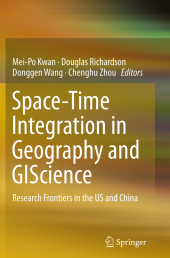 Neuerscheinungen 2016Stand: 2020-02-01 |
Schnellsuche
ISBN/Stichwort/Autor
|
Herderstraße 10
10625 Berlin
Tel.: 030 315 714 16
Fax 030 315 714 14
info@buchspektrum.de |

Mei-Po Kwan, Douglas Richardson, Donggen Wang, Chenghu Zhou
(Beteiligte)
Space-Time Integration in Geography and GIScience
Research Frontiers in the US and China
Herausgegeben von Kwan, Mei-Po; Richardson, Douglas; Wang, Donggen; Zhou, Chenghu
Softcover reprint of the original 1st ed. 2015. 2016. xii, 412 S. 46 SW-Abb., 82 Farbabb., 40 Tabellen.
Verlag/Jahr: SPRINGER NETHERLANDS; SPRINGER 2016
ISBN: 9401779058 (9401779058)
Neue ISBN: 978-9401779050 (9789401779050)
Preis und Lieferzeit: Bitte klicken
Space-time analysis is a rapidly growing research frontier in geography, GIS, and GIScience. Advances in integrated GPS/GIS technologies, the availability of large datasets (over time and space), and increased capacity to manage, integrate, model and visualize complex data in (near) real time, offer the GIS and geography communities extraordinary opportunities to begin to integrate sophisticated space-time analysis and models in the study of complex environmental and social systems, from climate change to infectious disease transmission.
This volume specifically focuses on research frontiers, comparative research, and research and application interactions in this field in the US and China, arguably the two most dynamic loci for this work today. The contributions to this book, by top researchers in China and the US, productively highlight the differences and similarities in approaches and directions for space-time analysis in the two countries. In light of the recent rapid progress in GIScience research on space-time integration in both countries, the book´s focus on research frontiers in these two countries will attract great interest in both countries and in other parts of the world as well as among related disciplines. In addition, the book also explores the impact of collaborative research and publications underway in this area between the US and China and will provide an overview of these collaborative efforts and programs.
This book will not only be of interest to university-based GIS researchers and students, but also to those interested in this new area of research and applications like researchers and developers in business, internet mapping and GIS and location based services (LBS).
Chapter 1: Introduction; Mei-Po Kwan, Douglas Richardson, Donggen Wang and Chenghu Zhou.- Chapter 2: Perspectives on Space and Time in US and Chinese Science; Michael F. Goodchild and Peng Gong.- Chapter 3: Space-Time Behavior Research and Application in China; Yanwei Chai, Zhilin Liu, Yan Zhang and Tana.- Chapter 4: Beyond Space (As We Knew It): Toward Temporally Integrated Geographies of Segregation, Health, and Accessibility; Mei-Po Kwan.- Chapter 5: The Influence of Built Environment on Walking Behavior: Measurement Issues, Theoretical Considerations, Modeling Methodologies and Chinese Empirical Studies; Hui Lin, Guibo Sun and Rongrong Li.- Chapter 6: Spatiotemporal Networks: Modeling, Storing, and Querying Temporally-Detailed Roadmaps; Michael R. Evans, KwangSoo Yang, Viswanath Gunturi, Betsy George and Shashi Shekhar.- Chapter 7: Spatiotemporal Critical Opportunity and Link Identification for Joint Participation Scheduling; Zhixiang Fang, Shih-Lung Shaw, Wei Tu and Qingquan Li.- Chapter 8: Robustness Analysis of City Road Network at Different Granularities; Yingying Duan, Feng Lu.- Chapter 9: Spatial Analysis of Census Mail Response Rates: 1990-2010; Daniel A. Griffith and Yongwan Chun.- Chapter 10: Creating Spatiotemporal Semantic Maps from Web Text Documents; Wei Wang and Kathleen Stewart.- Chapter 11: The HGIS Experience of Drawing Sub-county Unit Boundaries in the Jiangnan Region of Late Imperial China; Tam Ka-chai and So Kee-long Billy.- Chapter 12: Beyond the Boundary: New Insights from Inside the Space-time Prism; Ying Song and Harvey J. Miller.- Chapter 13: Detecting Activity Types and Trip Purposes from Passive GPS Data: A Data Mining Approach; Donggen Wang and Bingxia Sun.- Chapter 14: Quantitative Analysis of Climate Change and Human Crises in History; Harry F. Lee and David D. Zhang.- Chapter 15: Analyzing the Patterns of Space-Time Distances for Tracking the Diffusion of an Epidemic; Tzai-Hung Wen and Yu-Shiuan Tsai.- Chapter 16: Assessing Dynamic Exposure to Air Pollution; Mei-Po Kwan, Desheng Liu and Jaclyn Vogliano.- Chapter 17: Spatiotemporal Change Pattern Mining: A Multi-disciplinary Perspective; Xun Zhou, Shashi Shekhar and Pradeep Mohan.- Chapter 18: Contemporary Computing Technologies for Processing Big Spatiotemporal Data; Chaowei Yang, Min Sun, Kai Liu, Qunying Huang, Zhenlong Li, Zhipeng Gui, Yunfeng Jiang, Jizhe Xia, Manzhu Yu, Chen Xu, Peter Lostritto and Nanying Zhou.- Chapter 19: Short-Interval Monitoring of Land Use and Land Cover Change Using a Time Series of RADARSAT-2 Polarimetric SAR Images; Anthony Gar-On Yeh and Zhixin Qi.- Chapter 20: Space-Time Analytics of Tracks for the Understanding of Patterns of Life; May Yuan and Atsushi Nara.- Chapter 21: Real-time Space-time Integration in GIScience and Geography; Douglas Richardson.


